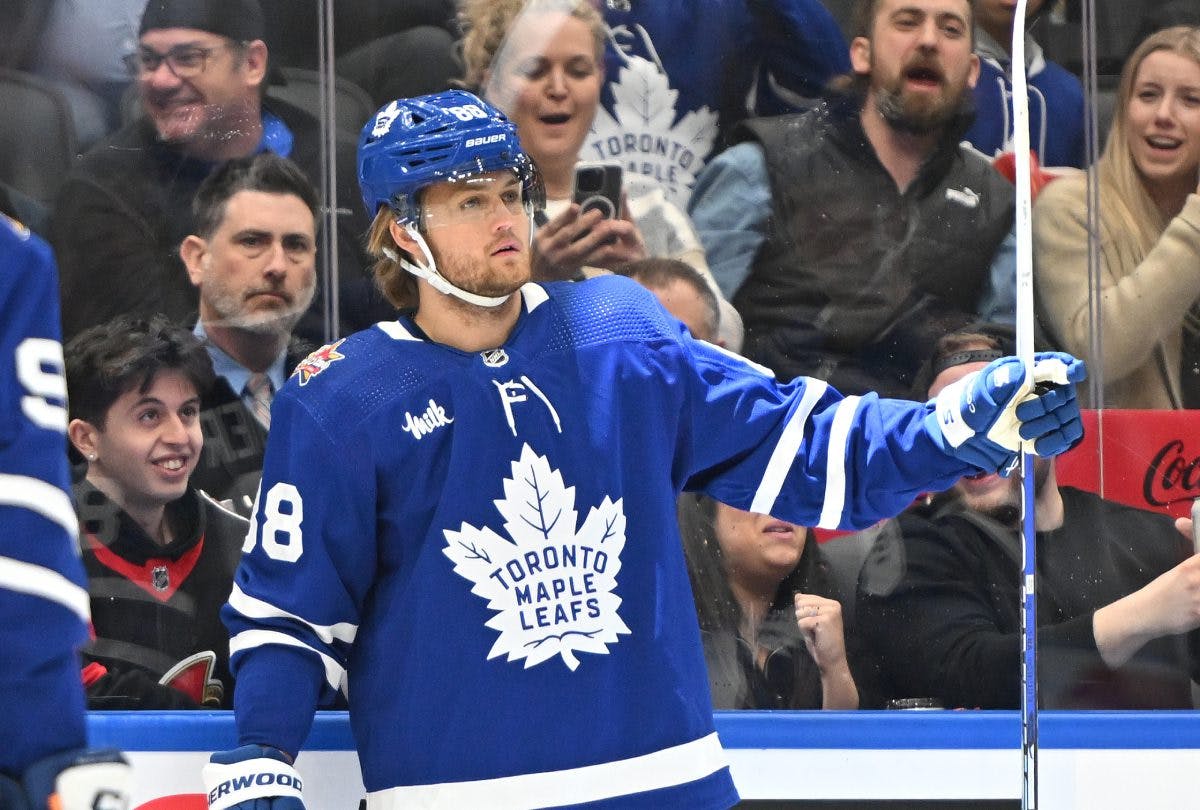The Leafs had to pay William Nylander. It’s what they do next that matters more

If you told me three months ago that Leaf Nation would spend the first half of 2023-24 holding their collective breath, speculating on the contract of their future free agent right winger, who was on pace for a career-best 120 points, I would’ve assumed you were talking about Mitch Marner. He’s eligible to sign an extension this July, after all.
Never would I have imagined the subject in question would be William Nylander. Not even his greatest apologist could’ve predicted what he’d accomplish this season. Equally threatening as a shooter and playmaker, showcasing his trademark ability to skate the puck out of trouble, he has been Toronto’s best player so many nights.
It’s what I call a good problem to have.
“Good” because any team wants to see its best players live up to their potential and then some. Nylander was working his way toward his epic breakout with an 80-point campaign two years ago and career highs of 40 goals and 87 points last season. Despite the Leafs’ reputation of being playoff chokers, he compiled 12 goals and 25 points in 25 games over his past three postseasons.
“Problem” because there’s simply no way GM Brad Treliving budgeted for the price tag Nylander’s astronomical stats would command this season. He might’ve been a $9 million player as recently as the summer. Maybe $10 million if we factored in the offers he might have received if he went to market. But on Jan. 8, when he signed his eight-year extension with the Maple Leafs? The AAV ballooned to $11.5 million.
That’s not to say Nylander didn’t earn his dollar figure. He’s playing at a world-class level. He’s one of the league’s most durable players. His breezy personality suits him for Toronto’s media pressure-cooker market perfectly. Since the start of the 2021-22 season, his 221 points in 200 games place him 14th in NHL scoring, between Jason Robertson and Sidney Crosby.
But he accomplished all that while playing on one of the better bargain deals in the league at just below $7 million. Now, Elias Pettersson’s future AAV notwithstanding, Nylander will begin his new pact as the league’s fifth-richest player. His cap hit will trail only those of only Auston Matthews, Nathan MacKinnon, Connor McDavid and Artemi Panarin, who have combined for three Rocket Richard Trophies, four Hart Trophies, three Calder Trophies and seven first-team all-star selections. Nylander, whose AAV exceeds even that of 61-goal scorer and good buddy David Pastrnak, certainly keeps elite company now and is being paid like someone expected to maintain his current level of production. He’ll face plenty of pressure to live up to a contract that will pay him until he’s 36 years old.
But in the present, what matters for the Leafs, their fans and Treliving was that they couldn’t continue without Nylander, even if it meant standing on their tiptoes to pay him at the absolute top of his market value. They’re a win-now team. They’ve extended superstar Matthews for four seasons after this one. They finally broke through and won their first playoff series in 19 years last season. Matthews is their best pure talent in franchise history and will likely hold many of their records by the time his career ends, so they have to shoot their shot during his peak, just as the Edmonton Oilers are doing with McDavid. If we’re zooming out to start a “What does the extension mean for the Leafs?” discussion, whether they should have signed Nylander is not the next question to ask. The answer to that one is yes. You’re a contender and one of your homegrown stars is pacing for 120 points. Next question.
The crucial question for Treliving now is: because he did probably overpay a bit, how does he make the deal work in the long term?
The rising salary cap certainly helps. Next season’s projected $4.2 million jump alone covers 36.5 percent of Nylander’s new number. After close to a five percent bump in the cap for 2024-25, it’s projected to increase another five percent the season after that. It also helps that, relative to his actual impact, Matthews took slightly below market value on his extension – it’s about the percentage of the cap, not the $13.25 million cap hit, don’t forget. Marner’s future AAV, which will likely leapfrog Nylander’s, isn’t the primary concern, either. Tavares’ contract ends the same year as Marner’s, freeing up $11 million, so Toronto can prioritize Marner before considering a re-up of Tavares for 2025-26 and beyond.
So this isn’t a doom-and-gloom scenario in which the Leafs are overspending like Clark Griswold putting in a pool in Christmas Vacation before getting his bonus. Toronto can afford the contract. It’s not going to sink them. They will continue to ice a competitive team founded on a collection of superstars, maintaining their high floor.
What Treliving’s future moves will determine: whether the Leafs’ top-heavy salary structure will prevent them from competing for a Stanley Cup. If you look at so many of the greatest teams of the salary-cap era, many of them, from the Chicago Blackhawks to the Los Angeles Kings, did their damage and won their rings before their stars reached their late 20s and had to be paid their mega deals. The Hawks’ last Stanley Cup came the season before Jonathan Toews and Patrick Kane jumped to a combined $21 million AAV. They stopped winning once their icons’ cap hits starting weighing down their budgets and forced them to throw support players overboard. The Leafs, based on their stars’ ages, find themselves at that same juncture now but have no championships and only one playoff series win to show for it.
The Tampa Bay Lightning bucked the trend by winning back-to-back championships in 2020 and 2021 despite having their superstars well past their first or even second contracts, but they had the luxury of no state income tax in Florida, allowing them to keep their elite players at reasonable cap hits, leaving room to bring in depth.
If there’s a model the Leafs must hope to follow going forward, it’s probably that of the 2016 and 2017 Pittsburgh Penguins. Those teams had the top-heavy structures, with most of their cap money allotted toward Sidney Crosby, Evgeni Malkin, Kris Letang, Phil Kessel and Marc-Andre Fleury. They also had cleaned out much of their pick and prospect capital via trades. But they were able to build championship teams by simply finding the right depth players for cheap. Their tremendous development pipeline turned seemingly secondary or tertiary prospects like Jake Guentzel, Bryan Rust and Conor Sheary into high-impact NHLers. They made smart trades for veterans like Patric Hornqvist, Carl Hagelin and Justin Schultz. They found value free agents like Ian Cole.
And therein lies the challenge for Treliving. To open next year, he’ll have the Core Four forwards eating up 53.3 percent of his cap space. Those same four have scored 60.4 percent of Toronto’s goals this season. The team’s pending UFAs include top-nine forwards Tyler Bertuzzi and Max Domi, not to mention top-four defenseman T.J. Brodie. It’s difficult to envision Treliving keeping everyone.
To push the Leafs forward toward contention after the superstars’ next contracts kick in, Treliving will have to do something his predecessor Kyle Dubas was known for: finding useful players at bargain AAVs. From Calle Jarnkrok to Michael Bunting to Jason Spezza and so on, Dubas had a strong batting average when it came to filing out his depth, even if he didn’t hit on every one of his attempts. The highlights of Treliving’s track record as a GM, dating back to his time with the Calgary Flames, primarily included big, cowboy-grade blockbuster trades, many of which worked out well, most notably the deal that brought Elias Lindholm and Noah Hanifin to Calgary. His history with signings has been more hit-and-miss. For every Jacob Markstrom and Chris Tanev there’s a James Neal or Troy Brouwer.
Now, with so much money tied up in a small group, Treliving’s margin for error on any other depth additions will be smaller. He can’t chuck $4.15 million in a bonfire again like he did with defenseman John Klingberg. The Leafs have to make every dollar count.
But that’s OK. Nylander’s performance painted them into a corner. They had to pay up. Keeping him, and complicating their cap situation in the future, is better than losing him for nothing.
Good problem to have.
_____

Discover Betano.ca – a premium Sports Betting and Online Casino experience. Offering numerous unique and dynamic betting options along with diverse digital and live casino games, Betano is where The Game Starts Now. 19+. Please play responsibly.
_____
Recently by Matt Larkin
More from Matt Larkin
- Whom should Canada choose for its goalie trio at the 2026 Olympics?
- 10 staggering on-pace stats to track so far in 2025-26 NHL season
- Matt Larkin’s midseason fantasy hockey top 300 player rankings for 2025-26
- This Week in the NHL: Will Carter Hart get start against former team?
- If Canucks do the unthinkable and trade Quinn Hughes…what would be his ideal landing spot?